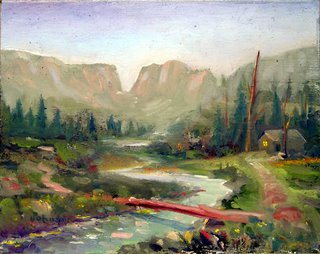 |
| The final painting as it was given to me. |
 |
| Why you shouldn't always trust Photoshop's (PhotoShop Elements anyway) automated color correction, although often it does an amazing job. |
At
my agility trial this weekend, the spouse of one of the competitors sat working at an artist's easel all weekend. On Sunday I finally asked whether he minded if I looked over his shoulder, and he said not at all, and then kindly asked my opinion. We chitchatted about the painting off and on over the next few hours. I started out by saying how amazing it was that he could create a wilderness scene while sitting at an agility trial with a big barn in front of him, but then quickly amended that to muse that, in fact, when I'm writing fiction, all I have in front of me is a keyboard and monitor, and I'm using words to paint a scene that might or might not exist anywhere in reality.
Every time I stopped by, the scene had changed. At first, there was a road winding off through the hills. By the end of the day, it was a stream flowing down into the foreground. In the morning, there were bluffs in the background to the left and the right; by the end of the day, there were several sets of differently shaped hills and bluffs at different distances in the background. The cabin and the log across the stream didn't appear until the very end.
Early in the day, it was a bluish sky and a mostly vaguely populated foreground and background. During the day, trees came and went, grassy areas came and went, the shape and makeup of the large dead tree on the right varied gradually.
It reminded me more and more of what writing is like. If you're lucky, the words and scenes and characters flow directly onto the page exactly as they need to be, but more often you discover more about a character as you write, and go back to earlier parts of the story to tweak here, erase there, add paragraphs somewhere else, to strengthen the story that you want to tell. The background might change, too. Perhaps you hang a gun on the wall in the first scene, intended the character to use it later, but eventually you omit the gun from the plot, and so you erase it from the wall. Or, vice-versa, you add it as it becomes necessary to the later story.
It has me thinking about writing fiction again.

